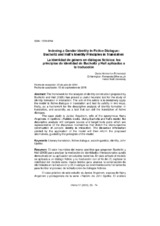Indexing a Gender Identity in Fictive Dialogue: Bucholtz and Hall’s Identity Principles in Translation
La identidad de género en diálogos ficticios: los principios de identidad de Bucholtz y Hall aplicados a la traducción
Autor
Harrington Férnandez, Owen
Editor
UCOPressFecha
2018Materia
Literary TranslationFictive dialogue
Sociolinguistics
Identity
Updike, John, 1932-2009
Traducción literaria
Diálogo ficticio
Sociolingüistica
Identidad
METS:
Mostrar el registro METSPREMIS:
Mostrar el registro PREMISMetadatos
Mostrar el registro completo del ítemResumen
The framework for the analysis of identity construction proposed by Bucholtz and Hall (2005) has proved a useful heuristic tool for the study of identity formation in interaction. The aim of this article is to tentatively apply the model to fictive dialogue in translation and test its validity in two ways, firstly, as a framework for the descriptive analysis of identity formation in translation, and secondly, as a tool that can aid the translation of fictive dialogue. The case study is Janice Angstrom, wife of the eponymous Harry Angstrom, in Updike’s «Rabbit» books. Using Bucholtz and Hall’s model, the descriptive analysis will compare source and target texts pairs which are representative of the discursive mismatches that distort the intersubjective construction of Janice’s identity in interaction. The discursive information yielded by the application of the model will then inform the proposed alternatives, guided by the principles of the model. El valor heurístico del marco analítico que proponen Bucholtz y Hall (2005) para analizar la mediación de identidades interaccionales queda demostrado en su aplicación en estudios recientes. En este artículo el modelo se aplicará a un diálogo ficticio y su traducción con el fin de (1) explorar la viabilidad del modelo como marco teórico para analizar la construcción de identidades en la traducción y (2) investigar su rendimiento como herramienta para facilitar el proceso de la traducción de diálogos ficticios. El caso práctico de este estudio es Janice Angstrom, esposa de Harry Angstrom y protagonista de la serie «Rabbit» de John Updike. El análisis descriptivo hará uso del modelo de Bucholtz y Hall para comparar el diálogo del texto de origen y el texto meta y para identificar discordancias discursivas en fragmentos del diálogo que distorsionan la construcción intersubjetiva de la identidad de Janice en la traducción. La información desarrollada a través de esta primera fase del análisis formará la base discursiva a través de la cual se ofrecerán alternativas que se atañen a los cinco principios del modelo.

